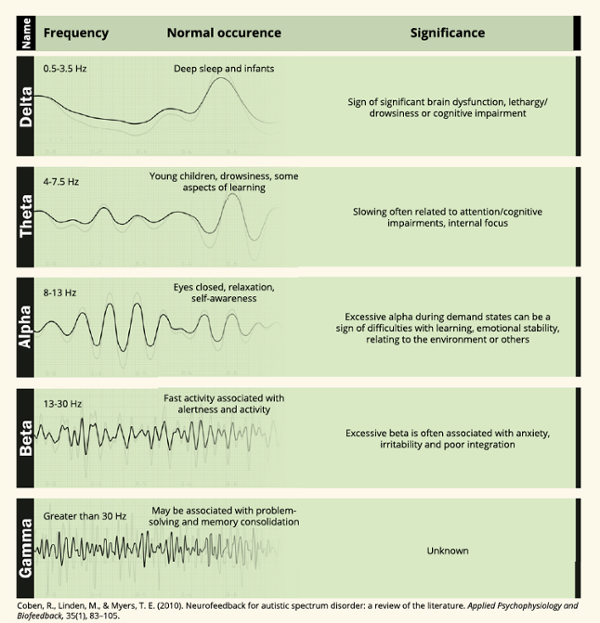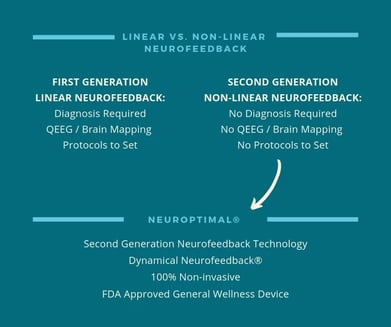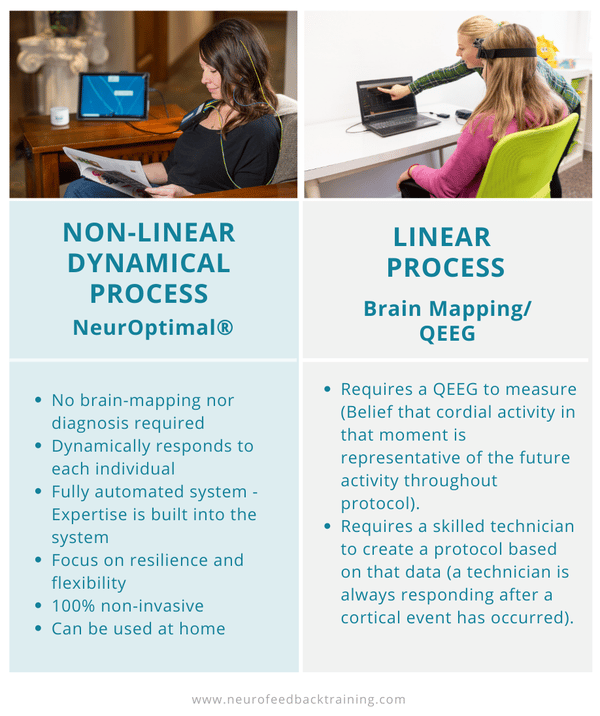Empower Yourself: Understand the older systems and new technology
)%206.webp)
Neurofeedback 101: What is Neurofeedback?
Since its inception in the 1970s, neurofeedback machines have worked by measuring the real-time activity of the brain, most frequently the electrical activity, or voltage, as measured in Hertz. This is because the brain communicates and carries out functions through electricity (and chemicals called neurotrasmitters).
EEG neurofeedback places sensors on the scalp and through the use of conductive paste the brain wave activity is collected and sent to an amplifier that changes the voltage into numbers. Those numbers are then sent into a computer device. The computer is installed with software that has mathematical formulations to take the brain activity numbers and translate them into brainwave frequencies, such as Alpha, Beta, Theta, etc. They are ranges of electrical activity associated with different brain activities. For example, Theta frequencies are active when people sleep, and Alpha brain waves occur when they are doing mental tasks.
Different neurofeedback software uses proprietary mathematical formulas to compute the meaningful change in the brain. Electrical impulses travel along the brain’s neurons at varying speeds but can reach 270 miles per second. At this speed, the software would then use auditory and/or visual cues to alert the individual to a change in the brain.

The First Generation Of Neurofeedback
Classical or Protocol Neurofeedback
Linear neurofeedback was the first generation of devices and is called EEG biofeedback systems. They work by having a neurofeedback trainer first take a map, called a QEEG, of the brain’s electrical patterns. This map allows the trainer to analyze brain activity. For example, looking to see if their Theta brainwaves are low or Alpha too high in comparison with the patterns of a healthy brain.
The map is then used as a reference point for the trainer to set protocols to help the brain to migrate towards normal and healthier brain wave patterns. When a brain map is not available, the clinician may use a diagnosis such as ADHD or anxiety to set the protocols.
Brainwave lengths represent measurements of the brain's electrical voltage, which is translated through mathematics into different frequencies. These frequencies have names, such as Theta, Beta, or Alpha, and are associated with different brain functions or states.

For example, based on your brain map, the clinician might assess that a client has too much Delta wave activity and not enough Alpha wave activity. She will create protocols to help the brain shift in those frequencies and will use client self-reports and mapping results to assess progress from session to session. A series of sessions will bring the client closer to optimal brain wellness.
There are a number of devices on the market, including EEGer, Cygnet, Lens, Brainasium, LoReta, and BrainPaint. Except for Cygnet, all require a brain map assessment or diagnosis before training can begin.
With linear brain training, a client relies on the skills of the clinician, who establishes a protocol program and adjusts it over a series of sessions. Errors in adjusting frequencies, i.e. over or under the training of different frequencies, can create temporary side effects. The skill of the clinician is important to consider with linear neurofeedback.
The Second generation of neurofeedback
Dynamical Neurofeedback (TM)
The second generation of neurofeedback devices arose as the speed of computing power approached the speed of the brain’s processing. The design of Dynamical Neurofeedback is based on non-linear mathematics. Why is this important? Because it mirrors how the brain naturally improves its functioning. It’s designed to harness the brain’s own ability to optimize.
The brain changes in a non-linear fashion, like the seasons, and the mathematical formulation for the Dynamical neurofeedback software mirrors this system, which is no small order. As example, the NeurOptimal system software does over 200,000 calculations every minute in analyzing the brainwaves. Specifically, the software looks at the brain’s electrical activity or voltage and determines state change by factoring in the changes in duration, amplitude, and frequencies over time.
Another significant advancement with non-linear neurofeedback is that it does not require the trainer to set protocols. Because the speed of computing has approached brain speed, the dynamical software interacts with the brain in real-time to give it feedback so that the individual’s brain can register its own state changes and shift anything that is not optimal.
The software operates fast. It collects 256 data points of brain activity per second! The device then uses micro-interruptions in music that is playing while the training session is running. Hearing is the main sense perception that the brain uses to detect changes in the environment. The precisely-timed interruptions act as an alert system telling the individual brain to pay attention to two sets of information: what is happening externally in the environment and what is happening internally in the body.
The training is giving this feedback thousands of times per session. The individual brain can then use this feedback to see its own automatic choices or habits and then decide if it wants to change those patterns.

The theory behind nonlinear neurofeedback training is that over the period of training sessions the process of learning which takes place results in the most efficient and effective use of energy by the brain to respond to current environmental needs. This process of gathering current data replaces maladaptive habitual responses. Once the brain has learned this new pattern of assessing needs, the individual notices changes in mental and emotional reactions.
Currently there is only one non-linear, dynamical neurofeedback system on the market, NeurOptimal®, made by Zengar Institute.
FAQs
How was neurofeedback discovered?
Is there science behind neurofeedback?
Is brain mapping the same as neurofeedback?
Brain mapping (qEEG) analyzes brain activity to identify imbalances, while neurofeedback uses this data for personalized brain training, teaching self-regulation through real-time feedback. The technological advance with Dynamical neurofeedback does not require a brain map to be done before neurofeedback. The mapping technology is integrated into the software in real-time.

